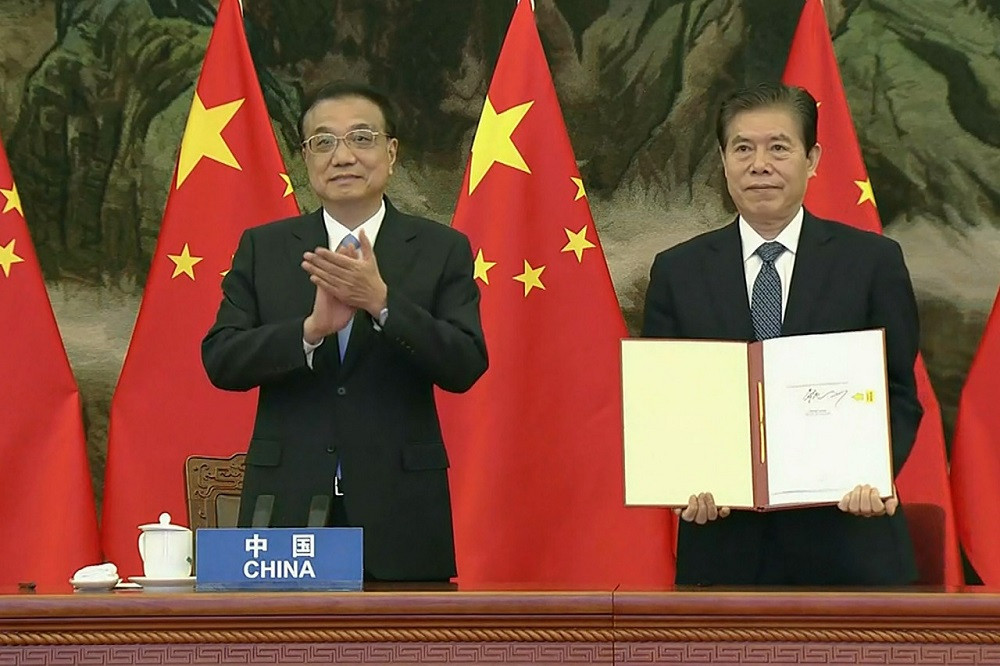Popular Reads
Top Results
Can't find what you're looking for?
View all search resultsPopular Reads
Top Results
Can't find what you're looking for?
View all search resultsRCEP's fruits come with challenge of keeping China in check
An outlook on its impact on Japan's economy is particularly rosy, some analysis suggested. At the same time, however, Japan will face difficulties keeping China's growing influence in the region in check, while its ally the United States remains at odds with China over human rights and other issues.
Change text size
Gift Premium Articles
to Anyone
W
ith the Regional Comprehensive Economic Partnership agreement taking effect Saturday, Japan and other member nations expect to revitalize the pandemic-hit economy through free trade in the economic bloc, regarded as the world's largest, covering about a third of the global economy.
An outlook on its impact on Japan's economy is particularly rosy, some analysis suggested. At the same time, however, Japan will face difficulties keeping China's growing influence in the region in check, while its ally the United States remains at odds with China over human rights and other issues.
"Japan would benefit the most from RCEP tariff concessions, largely because of trade diversion effects," a recent report published by the UN Conference on Trade and Development pointed out.
The 15-member RCEP was signed on Nov. 15, 2020, coming into force following ratification by at least six member states of the Association of Southeast Asian Nations and three non-ASEAN economies.
It incorporates Japan's first economic partnership agreement with China and South Korea, the two main destinations of its exports in Asia.
RCEP, seen as turning the region into "a new center of gravity for global trade," is expected to ultimately eliminate tariffs on over 90 percent of goods traded within the bloc comprised of economies of various sizes and at different stages of development.
RCEP consists of ASEAN -- Brunei, Cambodia, Indonesia, Laos, Malaysia, Myanmar, the Philippines, Singapore, Thailand and Vietnam -- plus Australia, China, Japan, New Zealand and South Korea, which also account for around 30 percent of the global population.
Japan's annual exports are expected to climb by about $20 billion, equivalent to almost a 5.5 percent increase from its 2019 exports to other RCEP members.
Overall, trade within the bloc is expected to increase by nearly $42 billion, equivalent to an almost 2 percent rise from the 2019 level, driven mainly through trade diversion away from nonmember nations, according to the UNCTAD report.
The Japanese government predicts the trade pact will help push up the country's real gross domestic product by 2.7 percent and add some 570,000 jobs.
Chief Cabinet Secretary Hirokazu Matsuno said in November, "It will contribute to the economic growth of Japan and the region. We will play a leading role in building an economic order based on rules and ensuring participating nations abide by the rules."
Chinese Premier Li Keqiang said China hopes to deepen international cooperation through the occasion of RCEP coming into force, China's state-run Xinhua News Agency has reported.
Besides tariff concessions, the RCEP agreement standardizes rules on investment, intellectual property and e-commerce, among other practices. It also promotes the optimization of supply chains in the region.
China's tariffs on auto parts and other items from Japan will be reduced in steps, leading to a jump in the ratio of tariff-free Japanese industrial goods headed to China to 86 percent from the current 8 percent.
As for imports, Japan will abolish tariffs on 56 percent of farm products from China, 49 percent of those from South Korea, and 61 percent of items from ASEAN, Australia and New Zealand.
Meanwhile, Japan retained tariffs on five sensitive agricultural product categories -- rice, beef and pork, wheat, dairy and sugar -- as well as tariffs on poultry and poultry products.
The government has said there will effectively be no negative impact on the domestic agriculture, forestry and fisheries industries.
Stephen Nagy, a senior associate professor at International Christian University with expertise in international relations in the Indo-Pacific, said recent developments with trade pacts would send a strong message to Washington to seriously consider engaging in an economic framework in the region.
The United States is not a member of RCEP or the Trans-Pacific Partnership, an 11-nation free trade agreement. China appears to be determined to build an economic network outside of US influence.
China, as well as Britain and Taiwan, recently applied for accession to the TPP, which has a higher threshold for membership than RCEP and was widely viewed as a counter to China's economic influence.
Analysts say that whether China can comply with the rules of RCEP will be a touchstone for it joining the TPP. The country has been criticized for its stance on intellectual property and market-distorting subsidies.
"If they try to work together to push and change China's direction, then it has to be through the lens of development and trade, infrastructure and connectivity," Nagy said, adding the US presence "will dilute China's influence in the region."
It would be "the best way to build the stable region," Nagy said, while he believes a new framework or something like "TPP 2.0" could receive the United States in the future.
Nagy said, "The contours of that are already being discussed," citing a visit to the region by U.S. Secretary of Commerce Gina Raimondo, during which she talked about the Indo-Pacific framework.
US President Joe Biden said the United States will explore "the development of an Indo-Pacific economic framework" during the East Asia Summit in late October, according to a report by the Congressional Research Service, the nonpartisan policy research arm of the US Congress.
In November, Biden dispatched Raimondo and Trade Representative Katherine Tai to Japan and other parts of Asia to start discussions on potential negotiations that could begin in early 2022.
The framework could comprise multiple agreements as the White House has indicated several topics of interest such as digital trade, supply chain resiliency, clean energy and infrastructure, while it has not offered details on what the framework might include, according to the study.
Another priority for Japan to contribute to the regional evolution is to persuade India to join RCEP down the road, as an expanded agreement including India will also broadly dilute China's influence in the region, Nagy said.









